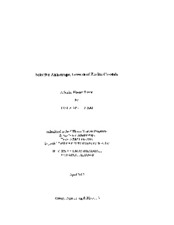| dc.description.abstract | Precise control over particle size and morphology is emerging as a critical issue in the design of nanostructured materials. The explosive growth of nanoparticle synthesis is a good example of this. As material chemists have developed the ability to synthesize discretely sized and shaped semi conducting and metal/metal oxide nanoparticles, new applications for these materials have emerged including catalysis, sensing, tags for biomolecules such as DNA, and components of colloidal arrays. While numerous advances have been made in nanoparticle synthesis, these have been generally restricted to materials possessing relatively simple structures (fcc, bcc, hcp) with small unit cells. To date, the ability to modulate particle size and shape of more complex oxides such as zeolites has not been demonstrated. That is the goal of this work, to develop the ability to synthesize one- and two-dimensional particles of complex materials, which could be integrated into micro devices such as sensors and electronics. To achieve this end we are attempting to grow zeolite particles in the confined water spaces formed in water/surfactant systems, using these "nanoreactors" to modulate zeolite growth. Our work to date has focused on the synthesis of two-dimensional (5x100x100 nm³) particles of ZSM-5 in the presence of sodium-AOT, an anionic surfactant that has a high propensity for forming lamellar bilayer (L[]) phases in solution. Our results from this system indicate that while we are forming high aspect ratio particles, they are in fact a sodium silicate phase, not the target phase ZSM-5. Current work is elucidating whether replacing the sodium with other cations such as tetrapropylammonium will give the desired ZSM-5 phase. Also, we are exploring the use of cationic surfactants that seem more promising for this application. If this approach is successful it opens new avenues to crystallizing complex solids with specific shape, size, or morphological properties, opening new applications for zeolite materials. | en |


